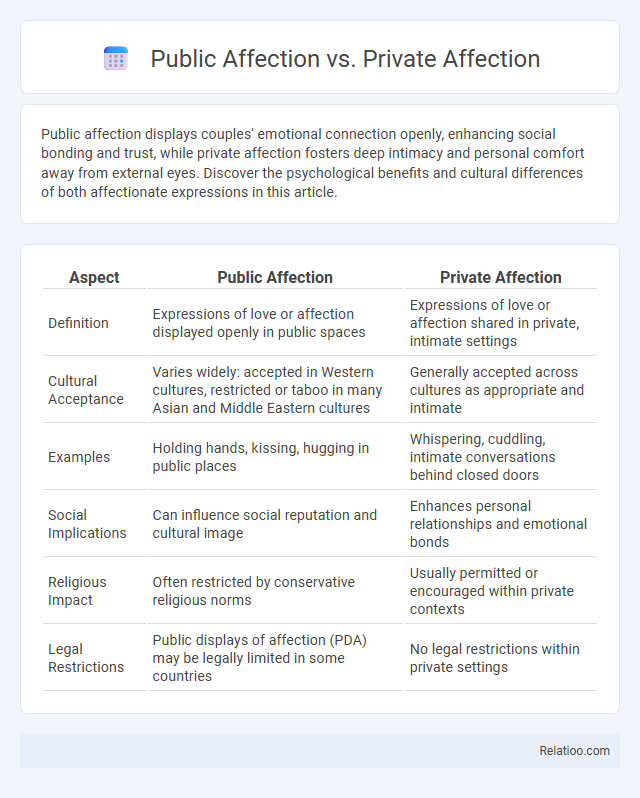Public affection displays couples' emotional connection openly, enhancing social bonding and trust, while private affection fosters deep intimacy and personal comfort away from external eyes. Discover the psychological benefits and cultural differences of both affectionate expressions in this article.
Table of Comparison
| Aspect | Public Affection | Private Affection |
|---|---|---|
| Definition | Expressions of love or affection displayed openly in public spaces | Expressions of love or affection shared in private, intimate settings |
| Cultural Acceptance | Varies widely: accepted in Western cultures, restricted or taboo in many Asian and Middle Eastern cultures | Generally accepted across cultures as appropriate and intimate |
| Examples | Holding hands, kissing, hugging in public places | Whispering, cuddling, intimate conversations behind closed doors |
| Social Implications | Can influence social reputation and cultural image | Enhances personal relationships and emotional bonds |
| Religious Impact | Often restricted by conservative religious norms | Usually permitted or encouraged within private contexts |
| Legal Restrictions | Public displays of affection (PDA) may be legally limited in some countries | No legal restrictions within private settings |
Understanding Affection: Public vs Private
Understanding affection involves recognizing the distinct expressions in public and private settings. Public affection typically includes subtle gestures like holding hands or brief hugs, designed to communicate connection without overwhelming social norms. Your private affection allows for deeper emotional bonding, providing a safe space for vulnerability and personalized expressions of love that are often absent in dating practices bound by external perceptions.
Cultural Perspectives on Affection Displays
Cultural perspectives shape the acceptability and expression of public affection, with some societies embracing public displays of affection (PDA) as a norm, while others consider such behavior inappropriate or taboo. Private affection, often viewed as a more intimate and culturally acceptable form of expressing love, varies in its significance across cultures, influencing how couples interact within different social contexts. Dating practices reflect these cultural attitudes, where certain cultures encourage public courtship displays and others emphasize discretion and privacy to maintain social harmony and respect.
Psychological Impact of Public Affection
Public affection, such as holding hands or light touches in open spaces, can enhance feelings of security and social connection for couples, positively impacting mental well-being by reducing stress and increasing happiness. Private affection provides a safe environment for deeper emotional bonds, fostering intimacy and vulnerability without fear of judgment. Your comfort with public displays of affection influences how you experience social acceptance and emotional expression in dating practices, shaping relationship satisfaction and psychological health.
The Role of Privacy in Romantic Relationships
Privacy plays a crucial role in maintaining intimacy and trust within romantic relationships by allowing partners to share personal moments without outside interference. Public affection can demonstrate commitment and connection, but too much exposure may lead to feelings of vulnerability or discomfort, influencing the quality of your relationship. Balancing private affection and dating practices ensures emotional security while fostering deeper, authentic bonds between partners.
Social Norms Influencing Affection
Social norms significantly shape how public affection, private affection, and dating practices are expressed and perceived, with cultural contexts determining what is socially acceptable in each setting. In many societies, private affection is more freely demonstrated, preserving intimacy, while public displays are often moderated to align with collective values and social decorum. Understanding these societal expectations helps you navigate relationships while respecting communal standards and avoiding social disapproval.
Comparing Benefits: Public Affection vs Private Affection
Public affection fosters social bonding and community validation, enhancing your relationship's visibility and perceived stability. Private affection deepens emotional intimacy, creating a secure space for vulnerability and trust between partners. Comparing benefits shows public displays boost external support and confidence, while private moments nurture personal connection and long-term relationship resilience.
Challenges and Misconceptions of Affection Displays
Public affection often faces social scrutiny and cultural taboos, creating challenges for couples who express love openly. Private affection can be misinterpreted as a lack of emotional connection or intimacy, complicating relationship dynamics. Dating practices vary widely across cultures, where misconceptions about appropriate affection displays can lead to misunderstandings and conflict between partners.
Affection Boundaries: Navigating Comfort Levels
Public affection involves expressing love or care openly in social settings, while private affection occurs in more intimate, personal spaces, each with distinct comfort boundaries. Dating practice requires clear communication and respect for your partner's comfort levels regarding physical and emotional expressions of affection, balancing openness with sensitivity. Setting and honoring these affection boundaries fosters trust and intimacy, ensuring both partners feel safe and respected throughout their relationship.
Effects on Relationship Satisfaction
Public affection, such as holding hands or hugging in social settings, often enhances relationship satisfaction by signaling commitment and boosting emotional closeness. Private affection allows deeper, more intimate bonding moments that reinforce trust and personal connection, which are critical for long-term relationship health. Your experience of dating practices that balance both public and private expressions of affection can significantly improve mutual understanding and overall relationship happiness.
Tips for Balancing Public and Private Affection
Balancing public and private affection requires clear communication and mutual understanding to respect each other's comfort levels in different social settings. You can cultivate intimacy by reserving more personal or vulnerable expressions of affection for private moments while maintaining appropriate, subtle displays in public. Prioritizing your partner's preferences and being mindful of context ensures a healthy blend of connection that strengthens your relationship both publicly and privately.

Infographic: Public Affection vs Private Affection
 relatioo.com
relatioo.com